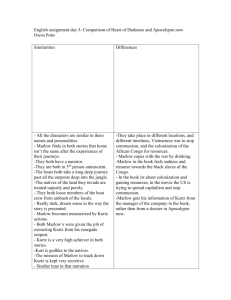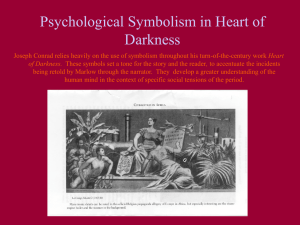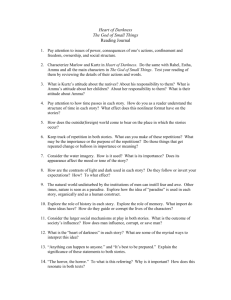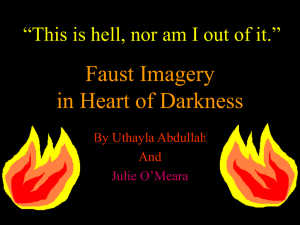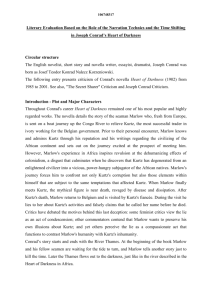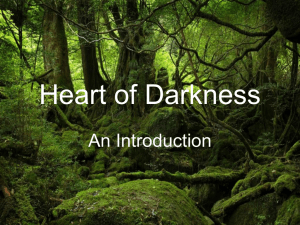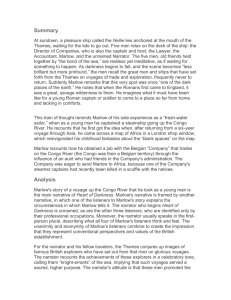Heart of Darkness: The Fates and Marlow's Journey
advertisement
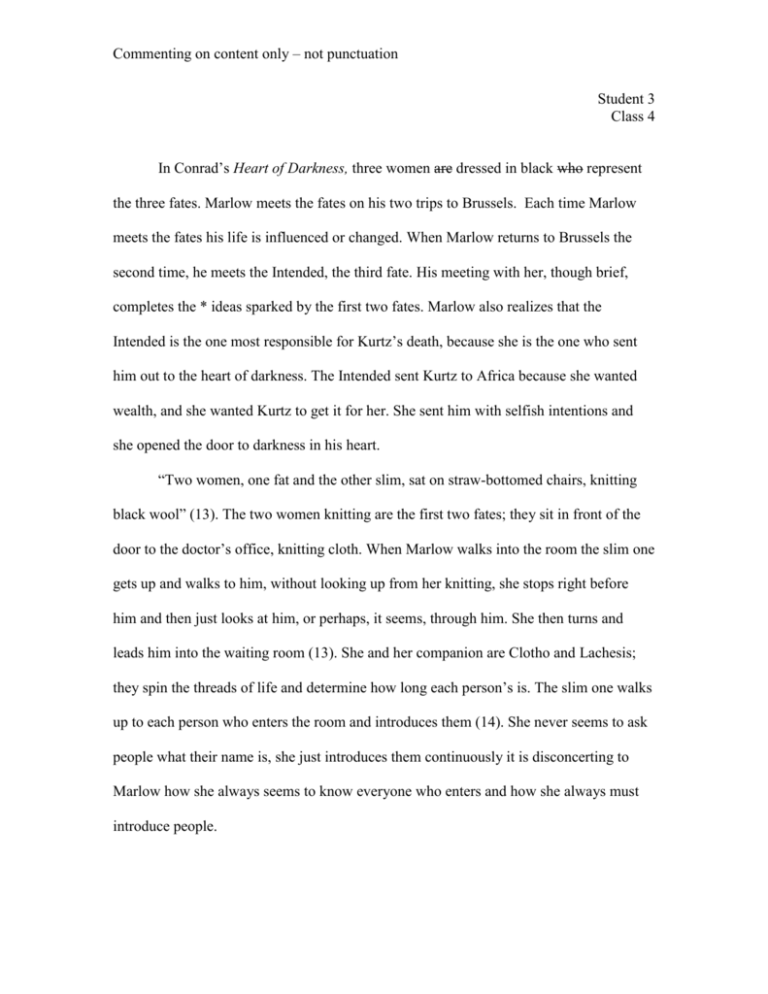
Commenting on content only – not punctuation Student 3 Class 4 In Conrad’s Heart of Darkness, three women are dressed in black who represent the three fates. Marlow meets the fates on his two trips to Brussels. Each time Marlow meets the fates his life is influenced or changed. When Marlow returns to Brussels the second time, he meets the Intended, the third fate. His meeting with her, though brief, completes the * ideas sparked by the first two fates. Marlow also realizes that the Intended is the one most responsible for Kurtz’s death, because she is the one who sent him out to the heart of darkness. The Intended sent Kurtz to Africa because she wanted wealth, and she wanted Kurtz to get it for her. She sent him with selfish intentions and she opened the door to darkness in his heart. “Two women, one fat and the other slim, sat on straw-bottomed chairs, knitting black wool” (13). The two women knitting are the first two fates; they sit in front of the door to the doctor’s office, knitting cloth. When Marlow walks into the room the slim one gets up and walks to him, without looking up from her knitting, she stops right before him and then just looks at him, or perhaps, it seems, through him. She then turns and leads him into the waiting room (13). She and her companion are Clotho and Lachesis; they spin the threads of life and determine how long each person’s is. The slim one walks up to each person who enters the room and introduces them (14). She never seems to ask people what their name is, she just introduces them continuously it is disconcerting to Marlow how she always seems to know everyone who enters and how she always must introduce people. Commenting on content only – not punctuation The fat one is Lachesis; she determines what will happen to people and how long their life will be. Whenever the slim one introduces a person Lachesis quickly glances up at each person. Marlow says, “the swift and indifferent placidity of that look troubled me” (14). To him it is as if the woman does not look at him as much as she looks through him. Marlow also says the looks were those of “unconcerned wisdom” (14), meaning that it seems the woman knows everything about each person who enters the room, even without the person having said anything, just as a fate would. Marlow feels that the women seems “uncanny and fateful” to him it seems that she knows who each person she meets is and what will happen to them. His meeting with Lachesis and Clotho is brief, but it does influence him. He says hthat the two women sit guarding the “door to darkness” (15). The door to darkness is literally the door into the doctor’s office, but the doctor’s office is the start of everything, it is the launching point of all the adventures which lead Marlow through the darkest places of the world and the human heart. Before Marlow leaves the two women he thinks “morituri te salutant” (15), which means, we who are about to die salute you. This shows that after he meets the fates his outlook on the upcoming adventure is not as bright, the two fates unsettle him, and they make him have doubts about what is to come. When Marlow returns to Brussels after Kurtz has died he meets the third fate, the Intended, Atropos. Atropos is the fate who cuts the threads of life. The Intended is the one most responsible for Kurtz’s death. When Marlow meets the Intended he seems to see her and Kurtz together, as she says she has survived he seems to hear Kurtz Commenting on content only – not punctuation whispering ‘the horror, the horror’ (112). In this way Conrad links the Intended with the horror, she is a part of the horror, and she is why Kurtz is dead. Throughout her conversation with Marlow the Intended claims that she loved Kurtz, and yet when Kurtz asked her to marry him she sent him to Africa to earn wealth for her. She was selfish, so she sent him out to the heart of darkness and she expected him to come back wealthy and just as he left. She claims to have known him best of anyone (113) yet she knows nothing of what he did in Africa, she still thinks he was a great man who did good things. However, he did not do good things, Kurtz did some of the worst things in Africa, and it was all because of the Intended. When she sent him to Africa she opened the door to darkness, she sent him to die. Marlow’s meeting with the Intended changes him, the one thing he cannot stand is lying, and yet, at the end of his visit he says what he believes to be a lie. The Intended’s house unsettles him, it makes him think of a place of death, a tomb (112), by the time he is near the end of his conversation with the Intended he is just ready to get out of the house. So, to spare her from the truth of Kurtz’s last words he tells her what he believes to be a lie. That is such an out of character thing for him, such an inexcusable thing, that he expects something drastic to happen; he even says that he expected the sky to fall on him (117). The fates all change Marlow, they all make him look deeper into the darkness of human nature and civilization, and they all help him see the dark truths and white lies that are the basis of what must be believed to survive. The meetings with the fates make Marlow realize how selfish and blinded civilization is, h willing it is to look away from truth and believe what is easiest, to believe what makes the world seem good. The fates Commenting on content only – not punctuation also make Marlow see the finality and the dark truth of Kurtz’s last words: “the horror, the horror” (105).
